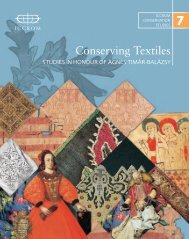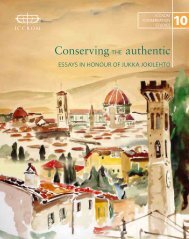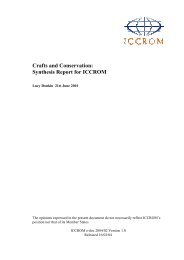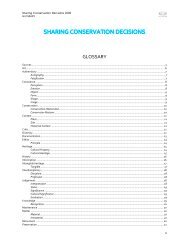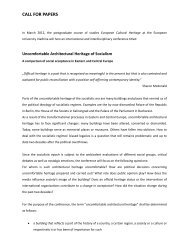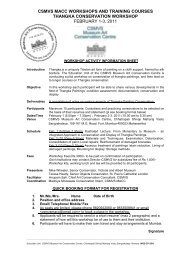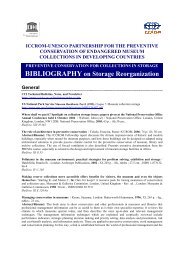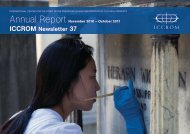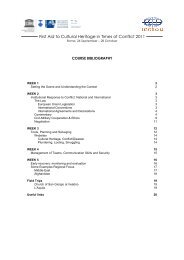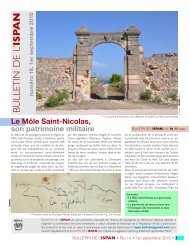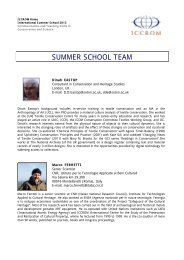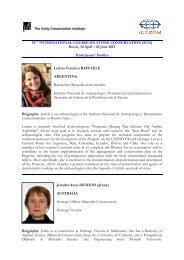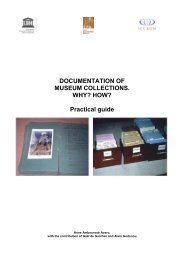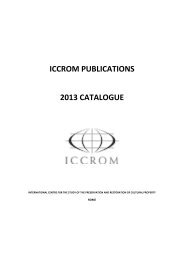part 1 - Iccrom
part 1 - Iccrom
part 1 - Iccrom
Create successful ePaper yourself
Turn your PDF publications into a flip-book with our unique Google optimized e-Paper software.
MEASURING HERITAGE CONSERVATION PERFORMANCE<br />
6th International Seminar on Urban Conservation<br />
affordances and combinations that give<br />
background and future opportunities.<br />
• Regulation potency: The site (‘place’) constitutes<br />
certain unofficial rules, customs,<br />
arrangements, etc.; maybe as traditions or<br />
by ‘self-regulating’ systems; and/or open<br />
like a net for further developments.<br />
• Time fluidity potency: The site (‘place’)<br />
has its ongoing realm and may be regarded<br />
as a ‘small’ universe which defines and/or<br />
lives its proceedings and ‘being’ (-in-time)<br />
within its cultural values.<br />
• Unlimitedness potency: The site (‘place’)<br />
is structured in different levels, realms,<br />
‘times’ and/or in modules with edges,<br />
limits, borders, intervals etc. that inhabit a<br />
certain kind of (controlled or open) interface<br />
between each other and the entities<br />
within and/or ‘outside’. This ability gives<br />
opportunities for fluent effects, links and<br />
further developments but also a ‘relaxed,<br />
soft background’ within the proceedings<br />
and between the (built) elements.<br />
• Usage potency: The site (‘place’) is essentially<br />
occupied by the core significance of<br />
its well known uses and associated customs,<br />
activities and events including the<br />
inherent useful objects and surrounding<br />
fabric. This accentuation means a close<br />
connection to the society’s reality, scopes<br />
and constraints and a necessary substantial<br />
openness to future developments.<br />
These 10 short (abstract and processual) explanations<br />
of qualities of complex places can only be a<br />
limited attempt and of course require more scientific,<br />
definite surveys. Imagining that all ten qualities<br />
are inherent in the combination of social and<br />
material factors, the explanations become more<br />
practical and closer to reality. Furthermore, when<br />
locally adopted, they achieve founding specifications,<br />
representing the flow of daily (urban) life.<br />
On every level we found those units of social and<br />
spatial factors (patterns). The conceptual combination<br />
of ‘usage and shape’ helps to differentiate the<br />
factors and to keep them together. It widens the<br />
understanding of dynamic phenomena in between<br />
the dilemma of being protected and enclosing openness<br />
to change. Focusing the preservation on built<br />
elements is obvious, but these ‘pictures’ are not sufficient<br />
to be helpful for the complicated decisions<br />
on how to accept or better to conceptualize (design)<br />
future necessities and possibilities. If we rely on the<br />
results of these processes we may lose the exceptional<br />
(design) pre-conditions. On the other hand<br />
the recent practice of protecting intangible heritage<br />
separately introduces new problems because such<br />
heritage might lose its imminent material conditions<br />
(see Pinto on farinha, 2005). Complex heritage<br />
depends on the unity of ‘hardware and software<br />
formations’. By understanding and integrating<br />
dynamic factors and social-spatial effects we expand<br />
the criterion, making it easier to im<strong>part</strong> significance<br />
and garner political acceptance within the essential<br />
‘lines’ of the preserved and protected heritage. For<br />
this we need an adequate, much deeper analysis of<br />
what is going on and how it is producing the hardware<br />
we are enthusiastic about.<br />
Buildings, cities, cultural territories — and feiras<br />
— are immanently ‘products and permanent processes’<br />
of social happenings;<br />
“The city… [or market]…is a state of mind, a<br />
body of customs and traditions, and of organized<br />
attitudes and sentiments that inhere in this<br />
tradition. The city… [or feira] …is not, in other<br />
words, merely a physical mechanism and an<br />
artificial construction. It is involved in the vital<br />
processes of the people who compose it, it is a<br />
product of nature and <strong>part</strong>icularly of human<br />
nature” (Park, 1915).<br />
7. …and beyond!<br />
Against this background we may discuss the preservation<br />
and monitoring of complex heritages; e.g.<br />
Dresden. Was the city’s traffic system <strong>part</strong> of this<br />
(former) cultural World Heritage? Of course it was (in<br />
history and on the actual maps), but not — I am sure<br />
— in an explicit and operant way. There are train<br />
paths, a few road bridges (mostly built in ‘modern’<br />
GDR times) over the Elbe river in the heart of the<br />
ex-heritage nearby the Elbterrassen. The river itself<br />
was and is a ‘traffic artery’. Was anyone thinking<br />
of traffic lines as an underlying <strong>part</strong> of (the history<br />
of) the cultural landscape and baroque city? Or how<br />
they would develop in future? 8 Or the new planned<br />
bridge over the Rhine in the middle of the World<br />
Heritage Upper Mittelrhein Valley — maybe it might<br />
be a new <strong>part</strong> of the genuine old European transportation<br />
Rhine-artery? In Brazil the extension of ministry<br />
buildings is clearly designed and ‘calculated’<br />
to maintain a relationship between single buildings<br />
and open space; is it sufficient to keep free just some<br />
(important) views throughout the townscape along<br />
Brendle, K. H. 2012. ¿Conservar uma feira livre? Or, preserving dynamic, complex heritage by accenting societal character and sociospatial<br />
conceptualization. In Zancheti, S. M. & K. Similä, eds. Measuring heritage conservation performance, pp. 42-52. Rome, ICCROM.<br />
49



